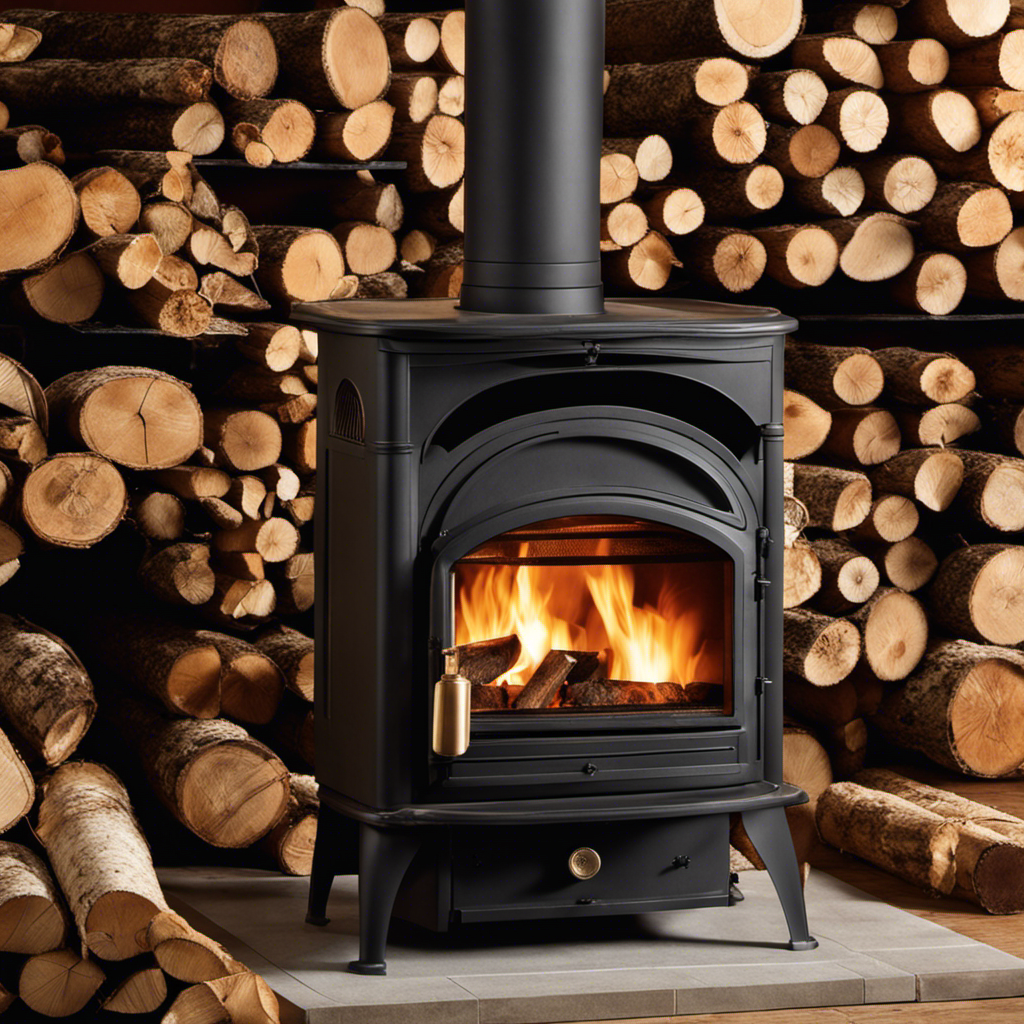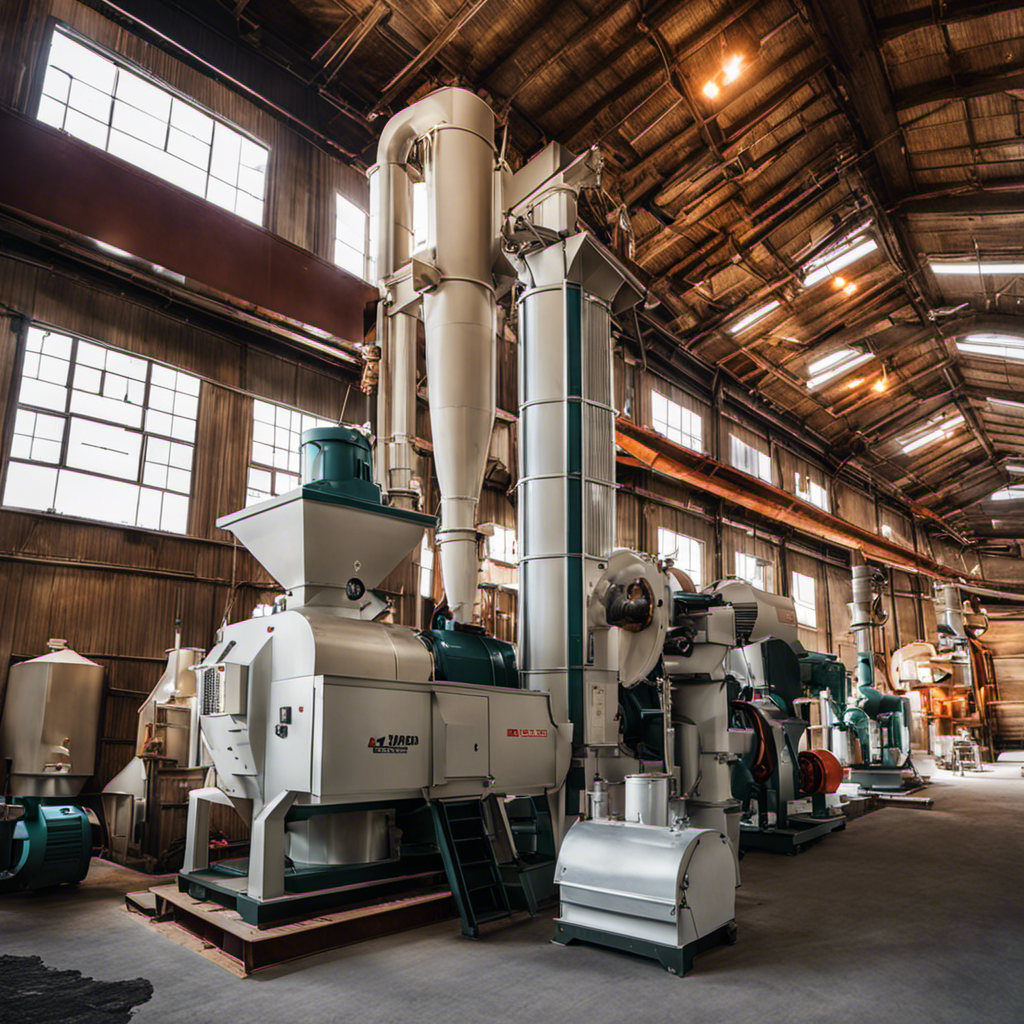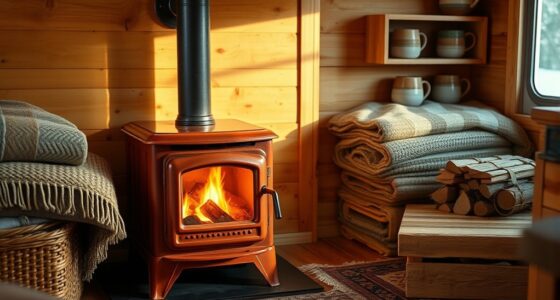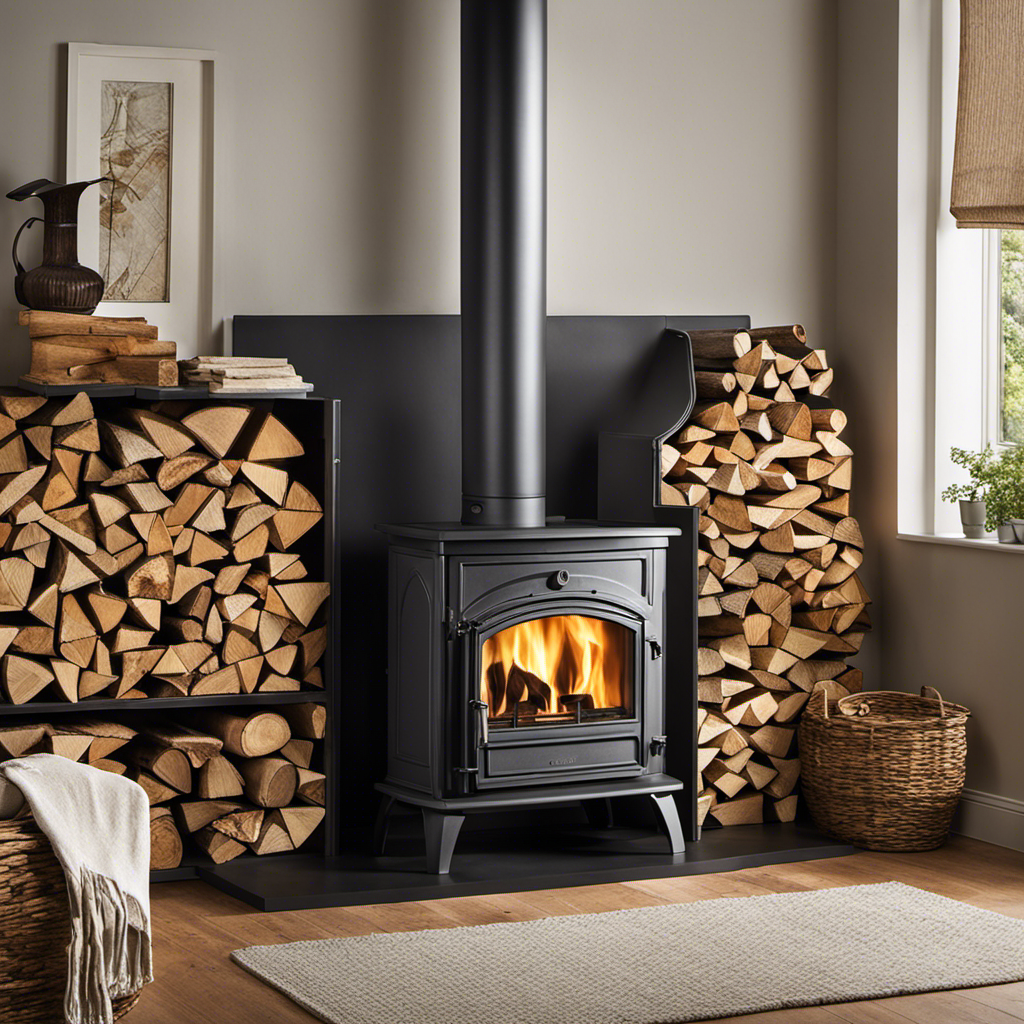We recognize your excitement to power your high-efficiency wood stove with top-notch materials. Like a match igniting a fire, we are here to provide direction.
Discover the types of wood that will maximize your stove’s efficiency and keep you warm all winter long. From moisture content to ideal size, we’ll share the knowledge you need to source sustainable wood.
Get ready to liberate your heating system and experience the warmth of a well-informed choice.
Key Takeaways
- Hardwoods like oak, maple, cherry, and hickory are the best types of wood for high-efficiency wood burning stoves.
- Hardwoods have a higher density, burn longer, and produce more heat compared to softwoods like pine or fir.
- Lower moisture content in hardwoods allows for a cleaner and more efficient burn.
- Sourcing sustainably harvested wood is crucial for wood burning stoves to minimize deforestation and support local communities.
Suitable Types of Wood for High-Efficiency Wood Burning Stoves
We’ve found that hardwoods like oak and maple are the most suitable types of wood for high-efficiency wood burning stoves. These woods have a higher density, which means they burn longer and produce more heat compared to softwoods like pine or fir. Hardwoods also have a lower moisture content, allowing for a cleaner and more efficient burn. They produce less smoke and emit fewer pollutants into the air, making them a better choice for those concerned about air quality and the environment. In addition, hardwoods tend to have a higher BTU (British Thermal Unit) content, meaning they generate more heat per unit of wood burned. This makes them ideal for high-efficiency wood burning stoves.
Now, let’s delve into the best wood for burning in high-efficiency stoves.
The Best Wood for Burning in High-Efficiency Stoves
When it comes to the best wood for burning in high-efficiency stoves, we prefer hardwoods like oak and maple due to their longer burn time and higher heat production. These wood species are known for their dense composition, which allows them to burn slowly and efficiently, providing a sustained source of heat.
Additionally, hardwoods produce fewer emissions and less creosote buildup, promoting a cleaner and safer burning experience. Other suitable wood species for high-efficiency stoves include cherry and hickory, which also offer excellent combustion efficiency and heat output.
It’s important to note that using dry, seasoned wood is crucial for optimal performance and efficiency. By choosing the right wood species and properly maintaining the stove, users can enjoy a more efficient and environmentally friendly heating experience.
The Importance of Wood Moisture Content
We always ensure that the wood we use has been properly seasoned and dried to achieve optimal burning efficiency, and we constantly monitor its moisture content to maintain an efficient and safe wood burning experience.
The wood drying process is crucial because the moisture content of the wood directly impacts the efficiency of our high-efficiency stoves. When wood is freshly cut, it contains a high amount of moisture, which can hinder its ability to burn efficiently. Wet wood not only produces less heat but also releases more smoke and harmful emissions. By properly drying the wood, we reduce its moisture content, allowing for a more efficient and cleaner burn. This not only maximizes the heat output but also minimizes the environmental impact.
Transitioning to the next section, choosing the ideal wood size for high-efficiency stoves is also important in achieving optimal burning efficiency.
Ideal Wood Size for High-Efficiency Stoves
When it comes to high-efficiency wood burning stoves, the size of the wood plays a crucial role in optimizing the stove’s performance.
The ideal wood size for these stoves is typically around 16 to 18 inches in length and 3 to 6 inches in diameter.
This size ensures that the wood burns efficiently, producing more heat and less smoke, while also allowing for easy stacking and airflow.
Optimal Wood Dimensions
We recommend cutting the wood into smaller dimensions for optimal burning efficiency in high-efficiency stoves. By doing so, you can maximize the heat output and reduce the amount of smoke produced. Here are some key points to consider:
-
Optimal Wood Density: Choose hardwoods like oak, maple, or birch, as they’ve a higher density and provide a longer burn time.
-
Wood Drying Techniques: It’s crucial to properly dry the wood before using it in a stove. Season the wood for at least six months to lower its moisture content to around 20%.
-
Splitting Wood: Splitting the wood into smaller pieces increases its surface area, allowing for better air circulation and more efficient combustion.
-
Size Matters: Cut the wood into lengths of about 16 inches or less to fit easily into the stove and promote even burning.
By following these recommendations, you can ensure that your high-efficiency stove operates at its best, providing you with a warm and efficient source of heat.
Now, let’s move on to discussing the importance of using efficient wood fuel in high-efficiency stoves.
Efficient Wood Fuel
Using properly seasoned hardwoods like oak, maple, or birch in high-efficiency stoves will consistently maximize heat output and reduce smoke production. When it comes to efficient wood selection for wood burning stoves, it is important to choose hardwoods that have been properly seasoned for optimal burning efficiency. Hardwoods, such as oak, maple, and birch, are dense and have a high heat value, making them ideal for high-efficiency stoves. These woods burn slower and produce more heat compared to softwoods like pine or fir. To help you understand the efficiency of different wood types, we have provided a table below:
| Wood Type | Heat Output | Smoke Production | Efficiency |
|---|---|---|---|
| Oak | High | Low | Excellent |
| Maple | High | Low | Excellent |
| Birch | High | Low | Excellent |
Sourcing Sustainable Wood for Wood Burning Stoves
We prioritize the acquisition of sustainably sourced wood for our wood burning stoves. As advocates of responsible wood harvesting, we believe in the importance of using wood from sustainable wood sources. Here are four reasons why sourcing sustainable wood is crucial for wood burning stoves:
- Environmental Preservation: By using sustainably sourced wood, we ensure the preservation of our forests and minimize deforestation.
- Carbon Neutrality: Responsibly harvested wood helps us reduce our carbon footprint, as trees absorb and store carbon dioxide during their growth.
- Local Economy Support: We prioritize sourcing wood locally, which supports local communities and promotes economic growth.
- Long-Term Availability: Sustainable wood sources guarantee a steady supply of wood for our wood burning stoves, ensuring their long-term viability.
Now, let’s move on to the comprehensive answer: what types of wood are best for high-efficiency wood burning stoves?
Which Types of Wood Burn Most Efficiently in Wood Burning Stoves?
When choosing wood for your highefficiency wood burning stoves, consider dense hardwoods like oak, hickory, and maple, as they burn hotter and longer than softwoods like pine and cedar. Their high energy content and lower moisture make them the most efficient choices for your wood-burning stove.
Comprehensive Answer: What Types of Wood Are Best for High-Efficiency Wood Burning Stoves?
Based on our research, hardwoods such as oak and maple are considered the best for high-efficiency wood burning stoves due to their higher energy content and longer burn times.
When it comes to wood species, these hardwoods have a higher density compared to softwoods like pine or fir, which means they can produce more heat per unit of volume. This higher heat output translates to a longer-lasting and more efficient burn, allowing you to maximize the warmth in your home while minimizing the amount of wood you need to use.
Additionally, hardwoods tend to have lower moisture content, which further contributes to their efficiency.
Frequently Asked Questions
Can Any Type of Wood Be Used in High-Efficiency Wood-Burning Stoves?
Yes, any type of wood can be used in high-efficiency wood-burning stoves. However, using seasoned wood has many benefits, such as increased heat output, reduced emissions, and improved stove performance.
Is It Necessary to Season the Wood Before Using It in a High-Efficiency Stove?
Yes, it is necessary to season wood before using it in a high-efficiency stove. Seasoned wood has lower moisture content, which leads to more efficient and cleaner burning, resulting in better heat output and reduced emissions.
How Often Should I Clean the Chimney of a High-Efficiency Wood-Burning Stove?
To properly maintain a high-efficiency wood-burning stove, it’s crucial to regularly clean the chimney. Regular chimney inspections are important for ensuring safety and efficiency. We should clean the chimney annually or more frequently if needed.
Can Softwoods Be Used in High-Efficiency Stoves, or Are Hardwoods Preferred?
Softwoods can be used in high-efficiency stoves, but hardwoods are preferred for their higher energy density and longer burn time. Hardwoods like oak and maple provide more heat, produce less smoke, and require less frequent refueling.
Can Wood Pellets Be Used in High-Efficiency Wood-Burning Stoves?
Using wood pellets in high-efficiency wood-burning stoves has both pros and cons. While they are convenient and produce less ash, they may not provide the same warmth and ambiance as traditional firewood.
Conclusion
In conclusion, when it comes to high-efficiency wood burning stoves, the best types of wood are hardwoods like oak, maple, and birch. These woods have a high heat output and burn slowly, making them ideal for efficient heating.
While some may argue that hardwoods are more expensive, their longer burn time and higher energy output make them a cost-effective choice in the long run.
So, choose the right wood for your stove and enjoy a warm and cozy home while reducing your environmental impact.
Growing up surrounded by the vast beauty of nature, Sierra was always drawn to the call of the wild. While others sought the comfort of the familiar, she ventured out, embracing the unpredictable and finding stories in the heartbeat of nature.
At the epicenter of every remarkable venture lies a dynamic team—a fusion of diverse talents, visions, and passions. The essence of Best Small Wood Stoves is crafted and refined by such a trio: Sierra, Logan, and Terra. Their collective expertise has transformed the platform into a leading authority on small wood stoves, radiating warmth and knowledge in equal measure.











